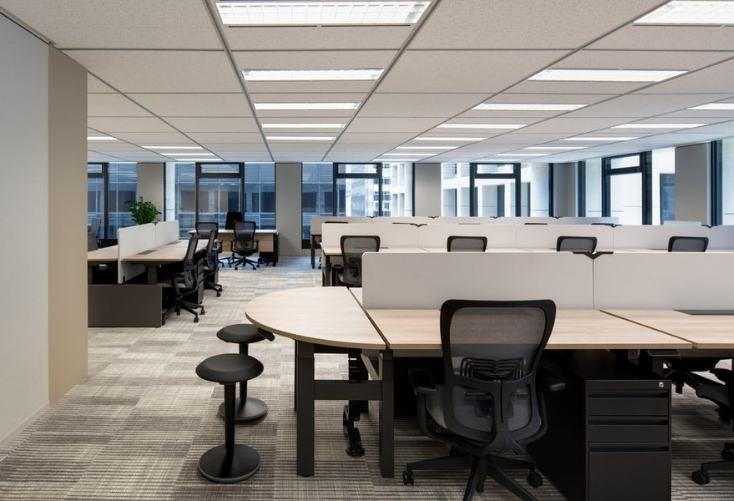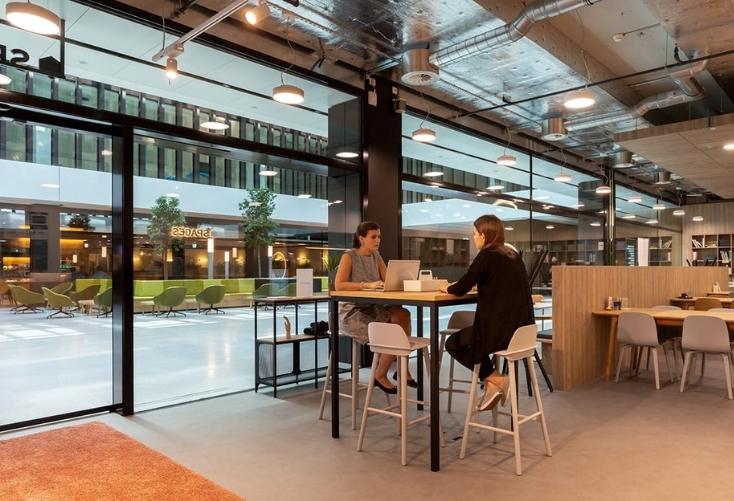Hand selected flexible workspace news from the most reliable sources to keep you ahead of the pack. We find all the latest news, so you don’t have to. Morning and afternoon updates. Stay in the know.
Here’s what you need to know today:
- Hong Kong Landlord Opens First Flexible Office
- The Future Of Flexible Offices
- UK Suburbs Outpace City Centers For Office Demand
- Stripe Employees Take Pay Cut To Work From Low-cost Cities
- French Startup Revamps Collaboration Platform For Hybrid Work
- Revamping The Future Of 9 To 5 Schedules
Hong Kong Landlord Opens First Flexible Office
Hongkong Land Holdings Ltd, the biggest landlord in Hong Kong’s Central business district, will open its first flexible office in Edinburgh Tower.
The owner has converted two floors of the tower to feature 320 desks that will open on Wednesday. Hong Kong Land said it would be gearing its services towards financial companies and professional services firms in an effort to accommodate businesses who are pivoting to smaller offices and short-term leases.
“The coworking space sector is actually performing better recently compared with last year,” said Martin Wong, head of research & consultancy for Greater China at Knight Frank LLP. “Many companies are taking the cautiously optimistic approach to expand, and coworking spaces provide them the flexibility in terms of capital costs and leasing terms.”
In Hong Kong, the flexible office industry is facing consolidation due to massive closures, with major operators like WeWork being forced to shut down spaces in the market. However, companies are taking advantage of the growing demand for agility and slowly taking up more space.

The Future Of Flexible Offices
The future of the workplace is uncertain, as it always has been to an extent. Now, as companies emerge from an unprecedented year or so, flexible offices are primed to be the ideal choice for tenants and investors who see it as a solution to their needs.
“One of the key outcomes from the pandemic is that a balanced portfolio and mix of long- and short-term space provide the greatest risk protection for business volatility,” said Beth Moore, SVP of client experience at Colliers. “Also, companies are looking to flex space to exit longer-term space commitments if employees are not coming back to the office 100 percent of the time.”
Although the benefits of flexible offices include efficient use of space and reduced risk due to short-term leases, they also have monetary value. In fact, Colliers recently worked with a company to incorporate a hybrid space into their operations, which led to savings of 66% over the course of eight years.
Will Burchfield, VP and head of Flex Advisory at Colliers, added that operators and landlords need to prioritize tenant choice and flexibility.
“Tenants thrive on choice, and with post-pandemic needs for an array of space, having a portion of your portfolio dedicated solely to this concept remains essential,” said Burchfield.
One of the most surprising trends to have emerged in recent months is the amount of landlords delving into the flex space sector according to both Moore and Burchfield. However, due to numerous tenants exiting their leases during the pandemic, landlords were forced to reconcile with the growing demand for flexibility.

UK Suburbs Outpace City Centers For Office Demand
New research The Instant Group shows that suburban offices are surpassing city centers for the first time in over a decade.
This growing demand is being powered by workers who do not want to work from home full-time, but also do not want to commute into larger cities. Companies who are pivoting to hybrid work arrangements have accelerated this push too.
According to the data, six out of nine major UK cities are seeking lower workstation rates than this time one year ago. However, locations such as Edgbaston, Bromley, Milton Keynes and Luton have seen a spike in demand for office space.
“As the UK comes out of lockdown, businesses want to reduce CAPEX where possible and be ‘cash-rich’, ready to invest in growth strategies, new markets or research and development rather than be heavily invested in real estate,” said John Williams, Director of The Instant Group. “The office market is responding to this and we are seeing more variation with a greater focus from landlords in providing the type of space and environment that employees now want.”

Stripe Employees Take Pay Cut To Work From Low-cost Cities
Payments company Stripe Inc. has seen a spike in employees taking up the firm on its offer to leave high-cost cities, get a $20,000 bonus, but also take a 10% cut to their compensation.
“We saw pretty major uptake,” said John Collison, Stripe’s co-founder and president. “There were a lot of people where they took advantage of all the remote working that was going on last year to be able to move to be closer to their families, to somewhere they wanted to move previously.”
Stripe has long been a pioneer of remote working arrangements, having hired remote engineers as early as 2013 and later opening a fully-remote engineering hub.
In March, the company became the most valuable startup in the U.S. with a $95 billion valuation after receiving $600 million in funding.

French Startup Revamps Collaboration Platform For Hybrid Work
French company Klaxoon has announced an update to its collaborative platform, as well as introduced a new hardware product.
Last year, the company revealed its software program Board that offered users the ability to collaborate while meeting in a video call. The interface allowed users to share ideas, collaborate with a whiteboard interface, add text and more.
The update will rename this service Board Hybrid, designing it for hybrid arrangements, as well as remote work.
Additionally, the company has launched a meeting room called Hybridity, a hexagonal-shaped capsule that features three seats, three screens, three cameras and three Klaxoon Box devices so users can be fully immersed in the meeting.
The Hybridity product takes up 5 square meters and can be moved within a workspace if need be since it is not secured to the ground.

Revamping The Future Of 9 To 5 Schedules
According to Paul Swinney, Director of Policy and Research at Centre for Cities, predicted that employees will return to the office for three or four days each week, but will eventually come back for the full week.
This forecast marks a significant contrast to other business leaders who have all but settled on the idea of a hybrid work or hub-and-spoke model moving forward. In fact, IWG CEO Mark Dixon stated that although the typical 9 to 5 could still play a role moving forward, it won’t be taking place in one single location.
Large organizations like Google and Facebook recognize this and have revealed that employees will not have to return to the office five days each week in the future.
Research from IWG has shown that 77% of employees are considering working out of a space closer to their homes, indicating that the hub-and-spoke model is ideal for many. Even more, a Stanford survey revealed that 55% of U.S. employees prefer a combination of home and office working.
“Your business doesn’t stop if you’re not all sitting in the same office every day,” said Dixon. “There is a new normal [and that’s] a local office, or an allowance to grab an office down the road.”
This is leading to a spike in flexible office demand, especially in suburban areas where employees live. For example, demand in some areas of London have fallen by 10% to 20%, while Uxbridge saw a 175% spike in demand.



 Dr. Gleb Tsipursky – The Office Whisperer
Dr. Gleb Tsipursky – The Office Whisperer Nirit Cohen – WorkFutures
Nirit Cohen – WorkFutures Angela Howard – Culture Expert
Angela Howard – Culture Expert Drew Jones – Design & Innovation
Drew Jones – Design & Innovation Jonathan Price – CRE & Flex Expert
Jonathan Price – CRE & Flex Expert













